You might wonder why any of the manufacturers in our Green Sticker 450cc Shootout would even bother to try and build a machine that can offer exhilarating performance while adhering to the EPA’s stringent—and some would argue, ridiculous—emissions certification standards for off-road motorcycles ridden on public land.
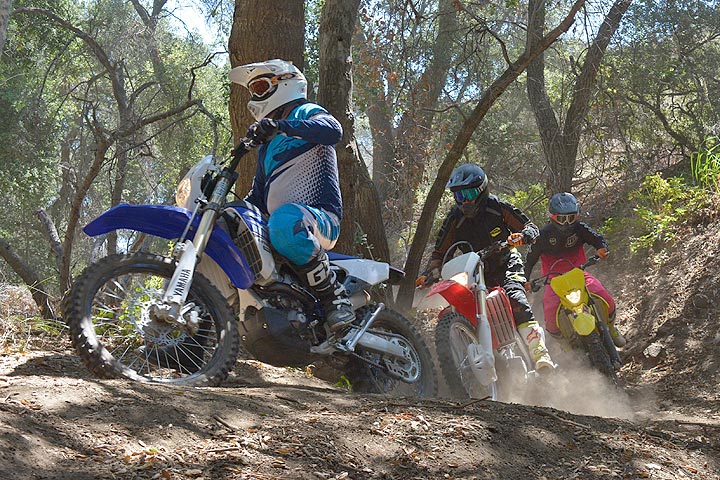
But there may be a method to the madness. After all, when it comes to air pollution, green is good, and while the Honda CRF450X, Suzuki RMX450Z and Yamaha WR450F might not blow anyone’s mind in terms of outright performance, the three machines here represent not only the present in terms of emissions-legal off-road technology, they may well be harbingers of the future for all big-bore off-road and motocross machines. In light of our recent story on California’s emissions proposals for off-road motorcycles, dirt bikes with the proper emissions equipment such as these could set the standard for strictly off-road dirtbike performance in the future. Yeah, it really could happen.
Sure, you say, but the European manufacturers have better-performing machines than these, and they’re street-legal! True that, but you also have to take those race-ready street-legal enduros for what they are, a Band-Aid fix to the challenge of meeting existing emissions standards. It’s a really crafty way of following emissions laws as they currently exist, but the likelihood is still strong that, somewhere down the road, all streetbikes may have to undergo the same kind of tailpipe-sniffing emissions testing as automobiles. That could change the game to an even greater extent, and it would likely bring in an end to what is effectively a loophole.
To that end, we applaud Honda, Suzuki and Yamaha for sticking to their guns in building off-road-only Green Sticker arena, and that’s why we chose these three machines for this comparison. We also did it because we know that all three of them, although they are 2017 models, are returning unchanged for 2018, save for maybe a graphics update.
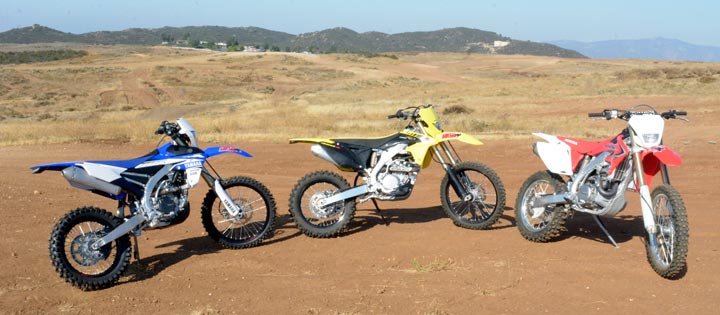
So we went ahead and busted some brush with the Honda, Suzuki and Yamaha for a Green Sticker 450cc Shootout, and we took notes to determine which of these three machines reigns supreme in what is a very challenging if not competitive category. When the drastically reduced carbon monoxide, oxides of nitrogen and hydrocarbon smoke cleared, we found out that all three machines are plenty of fun, but one bike did stand out above the others.
How Do They Do It?
Make no mistake about it: All three of these emissions-legal 450cc off-roaders have the potential to not be turdish. They boast engine performance technology that is, for the most part, either state-of-the-art or a generation (or two) removed from their full fire-breathing motocross siblings. That said, getting any one of them to pass EPA emissions standards is no picnic, and it involves sacrificing outright performance to achieve the goal. The question is by just how much.
In the case of the still-carbureted Honda CRF450X, emissions are mitigated by a secondary air-injection system that introduces filtered air into the exhaust gases in the exhaust port, which helps to burn the unburned and/or partially burned fuel in the exhaust system before it exits the tailpipe. The X model also features a closed crankcase to prevent emissions from escaping into the atmosphere. Any gases that make their way past the rings and into the crankcase are returned via a hose to the combustion chamber through the airbox for another go at the combustion process. Additionally, the CRF450X’s 40mm Keihin carburetor is set up with very lean jetting, and the X’s airbox features a tiny snorkel that greatly restricts incoming air, the latter in the name of reducing noise emissions. The CRF450X muffler also features an exhaust diffuser that further reduces noise but also hinders exhaust flow.
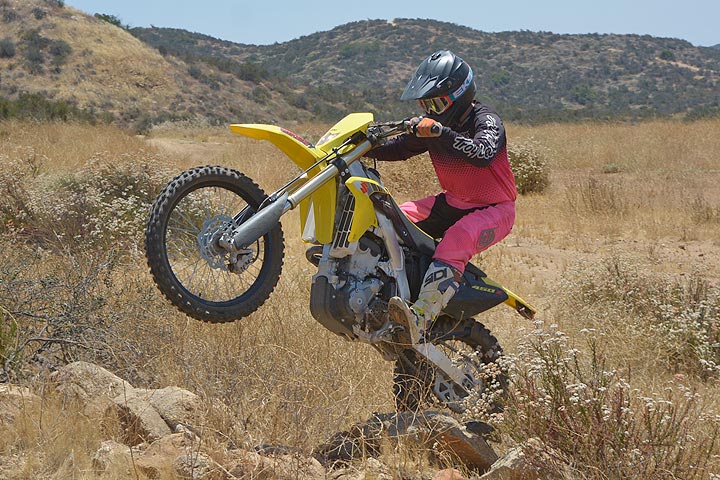
The Suzuki RMX450Z and Yamaha WR450F are fuel-injected, but they, too, are saddled with performance-robbing parts in the name of cleaner tailpipe emissions and reduced noise. Both machines feature lean-burn ECUs that are optimized to regulate exhaust emissions and cannot be reprogrammed. Both also feature screws that limit throttle travel, thus restricting how far their respective Keihin throttle body butterflies (41mm for the Suzuki and 44mm for the Yamaha) can open. By way of limiting rpm, these screws effectively restrict the amount of “good air” their engines can ingest and thus the “bad air” they can expel. While the Yamaha’s throttle stop screw is located in the throttle assembly, the Suzuki’s is located in the RMX’s throttle body housing itself, and it limits the throttle body opening to just 32.9 degrees at “wide open” throttle. To reduce noise emissions, both the Suzuki and the Yamaha feature an airbox snorkel that restricts air into their engines and mufflers with tiny tailpipes bolted in place just inside their endcaps. Here again, exhaust flow is greatly reduced, which hurts performance.
So why not just rip all that stuff off and tell you what these bikes are really capable of? Well, that’s would kind of be missing the point of a Green Sticker 450cc Shootout, wouldn’t it. Besides, we did that, and while all three perform much better, their rankings at the end of the day are unchanged.
Tell Me Something Good
Okay, we will. In two out of three cases, the stock emissions equipment on this trio of Green Sticker 450cc Shootout contenders doesn’t kill their off-road fun factor—and in the third case only when one attempts to hustle the machine above cow-trailing speeds. On top of that, all-three feature convenient electric start as standard equipment with kick starters onboard as a backup.
As soon as we hit the trail, we knew that the battle for engine supremacy was going to come down to the WR450F and the CRF450X, and which way it tilted would really boil down to what kind of rider was on a given machine. The casual trail rider and desert aficionado will probably favor the Honda CRF450X’s Unicam engine because of its brawny yet gentle low-end and luscious mid-range, which makes the bike extremely easy to ride fast and very forgiving in tight, technical terrain. Throttle response through its TPS-controlled carburetor is smooth and lurch-free, and you can lug the X motor down to really low rpm, and it will always pick up the slack. Although none of our testers needed to use it much, the CRF’s clutch action is linear, more than a match for its precise-shifting five-speed transmission.
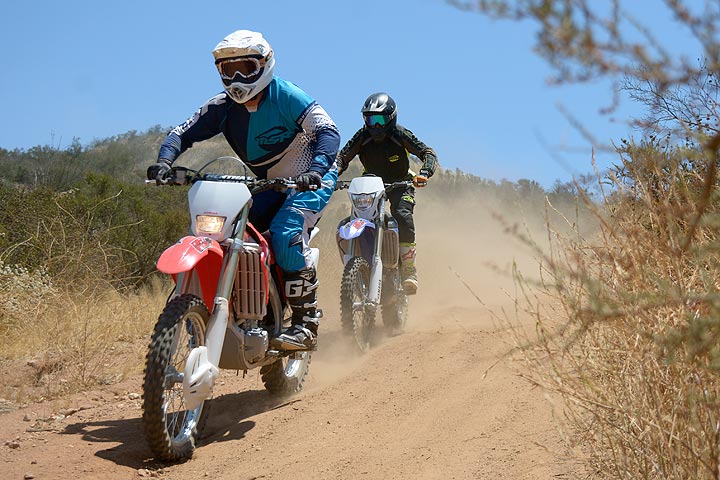
Where the Honda comes up a little short is in its noticeable lack of snap and thin top-end feel—it simply lacks the zing and zest of the WR450F. The Yamaha’s slightly larger bore and slightly shorter stroke, reverse-incline DOHC engine delivers more motocross-style snap than the Honda’s. It’s fuel-injection provides crisp and clean throttle response, but we found that a quick flick of the clutch lever was useful when in helping the WR pick through rocks and over logs and other obstacles. The flip side is that the Yamaha also sports a healthy mid-range and a zippy top end. The Yammie is simply happier to get the job done when it’s spinning than when it is just plodding along. The power delivery gives the WR a racier feel than the other two machines in this comparison, and that gave it the edge with our racer-oriented test team. Gear spacing on the Yamaha is perfect, and its clutch action was precise, although its shifting action isn’t as smooth as the Honda’s or the Suzuki’s.
That the Suzuki RMX450Z ‘s precise shifting action and decent clutch feel are welcome traits, because its DOHC engine is clearly the most choked of this trio. With so little throttle travel to work with, the rider has to pay careful attention to shifting and clutching when riding at an aggressive pace. The RMX makes a fair amount of low-end power, just as you’d expect from a 450cc Single, but it simply doesn’t pull very hard, feeling more like a 250 than a 450. It also revs slower than the other two, and we think that’s simply because the big engine isn’t getting enough air or fuel. The lean-feeling, sluggish throttle response was noticeable, as was the fact that the Suzuki engine radiated more heat than the other two bikes in this comparison. It also stalled on many occasions due to its lean fueling. Not cool.
Cornering The Market?
On the other hand, the RMX450Z handles extremely well when the going gets slow and technical. Although it doesn’t have the latest-generation RM-Z450 frame, the RMX’s circa 2009 twin spar aluminum perimeter is legendary for its steering precision. Suzuki engineers retuned the chassis to give it more flex for off-road, and it clearly favors tight and technical terrain. While its 58.5-inch wheelbase is the longest in this test, and its 29° rake and 5.1-inch trail, are the most relaxed of the three bikes, the RMX gives up nothing in terms of low-speed cornering. Weighing 271.2 lbs. with its 1.6-gallon tank filled to capacity, the RMX actually feels lighter than it is, thanks to a center of gravity that feels lower than the other two bikes. Although we wouldn’t say that it totally hides it girth, the Suzuki’s light-steering feel and good front-end traction in slippery or loose corners make it a single-track superstar. Pick up the pace, however, and the RMX chassis’ motocross breeding comes through in the form of a stiff and jarring ride quality.
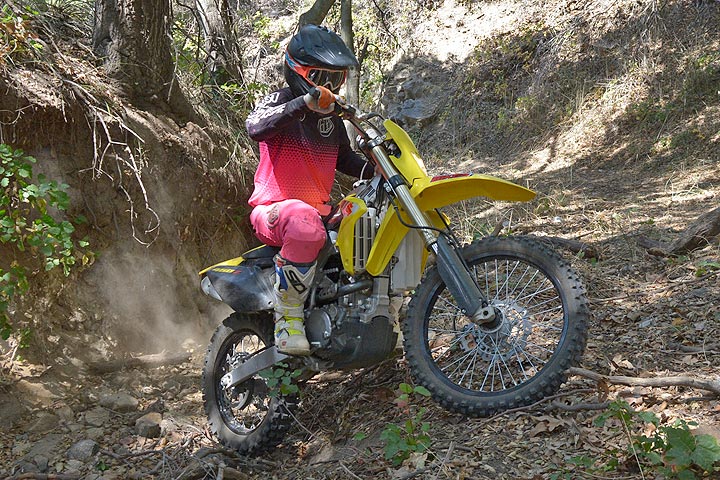
The CRF450X’s handling is almost directly the opposite in that the harder you push it, the better it feels. The Honda only weighs about half a pound more than the Suzuki, but at slower speeds it might as well be 10 lbs. Even though CRF’s 58.3-inch wheelbase is a little shorter and its 27.1°rake and 4.3-inch trail are tighter, the Big Red machine doesn’t like to turn all that tightly. Compared to the Suzuki, the Honda feels as if it as a higher center of gravity, and its low-speed steering is slower and heavier, forcing the rider to steer with the rear wheel to keep the front pointed where he or she wants it.
At higher speeds, however, the CRF450X chassis is as stable as a train, and it likes to plow through trail obstacles at speed rather than go around them. Of course, part of the Honda’s turning character may have to do with the Honda Progressive Steering Damper (HPSD) fitted to the X. The HPSD is designed to increase in damping force as the steering deflects further from its center line (straight ahead), but also reacts to quick steering inputs, such as when the wheel deflects off a rock. On the plus side, the HPSD may also be why the CRF’s aluminum perimeter chassis is also the most forgiving of this group in high-speed terrain. It’s really no wonder that the Honda has so many Baja race victories.
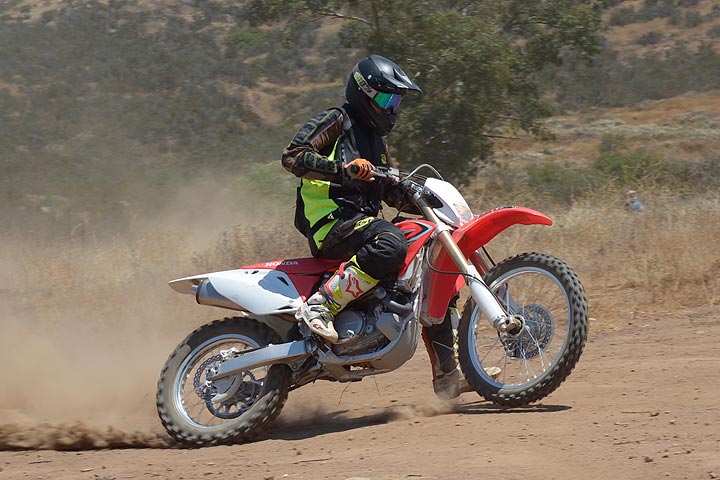
The Yamaha WR450F’s handling is the favorite of our test team, however, mostly because it splits the difference between its competitors. Its bilateral beam aluminum chassis is more akin to the Suzuki than the Honda. With a 57.7-inch wheelbase, 26.3° rake and 4.5-inch trail, the Yamaha feels light and agile in the slow going on tight trails yet maintains it composure on fire roads and in open desert terrain. It doesn’t steer quite as quickly as the Suzuki, and it isn’t quite as stable as the Honda, but the WR definitely finds that happy medium between the two. The Yamaha is the lightest bike in this test, but again only by little more than half a pound, hitting our scales at 270 lbs. with a full drink of fuel in its 2-gallon tank. The WR simply stands out by not standing out, with a neutral feel, well-heeled cornering manners and good high-speed stability.
A Jolt of Reality
None of these Green Sticker 450cc Shootout combatants are fitted with air forks, and we’re thankful for that because we think that most air forks basically suck; they require too much fiddling for not that great of a gain—and sometimes a loss—in suspension performance. It’s nice to see the OEMs waking up to the fact that consumers aren’t air fork fans. The evidence is the shift by Honda and now Suzuki away from air forks on their flagship 450cc motocrossers.
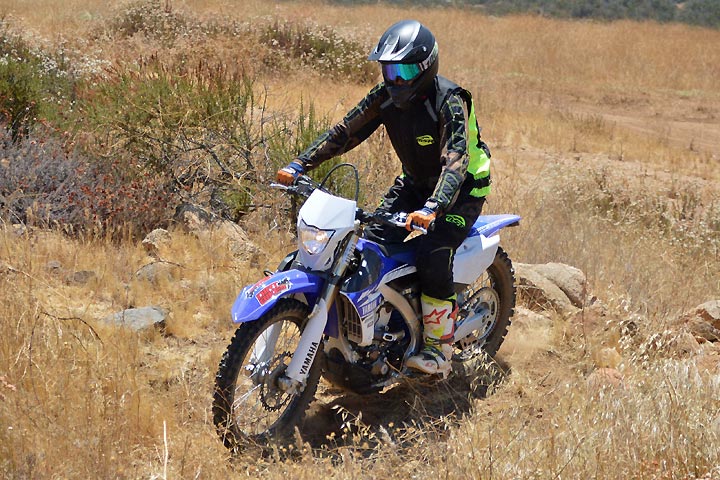
The Yamaha WR450F’s KYB suspension is the most up-to-date in this comparison. Its 48mm KYB Speed Sensitive System fork and KYB piggyback shock are pulled from the 2017 Yamaha YZ450F (the 2018 YZ has a next-generation fork) and altered with off-road valving and softer spring rates than the motocross version while remaining fully adjustable. Suspension travel is 12.2 inches up front and 12.5 inches out back.
On the trail, the Yamaha delivers excellent suspension performance regardless of the terrain. Our expert testers did complain that the front and rear ends are a little on the soft side, but that’s to be expected. For the rest of us, the WR’s suspension is right in the pocket of comfort and control whether the going is slow and rocky or fast and rough.
The Honda CRF450X isn’t too far behind the WR despite having the oldest-gen suspension in this shootout. Its proven and reliable inverted 47mm Showa cartridge fork, Pro-Link rising rate linkage and fully adjustable Showa shock can tackle rough off-road chop at high velocity while maintaining sufficient low-speed suppleness when grunting through rocks and over roots. Again, some super-fast experts might find the stock Honda suspension to be valved and sprung a little soft, but it’s very good for its intended use.
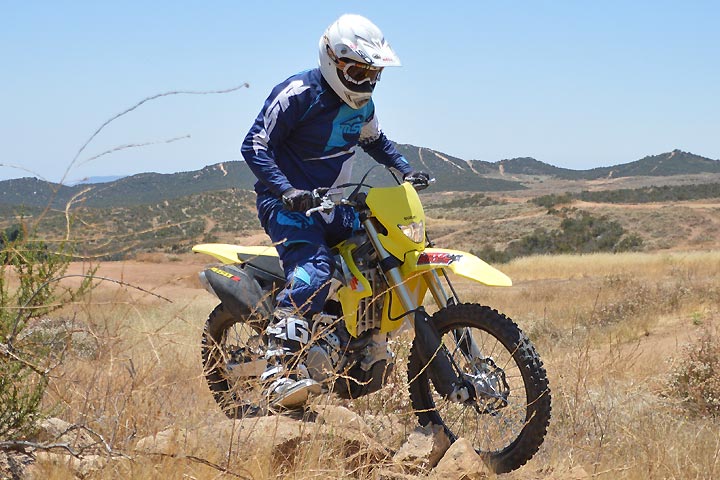
The RMX450Z comes up a little short to the WR450F and the CRF450X in the suspension department of our Green Sticker 450cc Shootout. Its 47mm Showa coil-spring fork and fully adjustable Showa shock are noticeably valved on the soft side. Its 12.2 inches of front and rear travel that is plush at lower speeds but tends mush out quickly when the trail pace is fast. Dialing more compression damping helps to prevent bottoming in G-out hits amplifies the chassis stiffness. The RMX is best enjoyed in slower and more technical spaces. Of course, having said that, we also have to note that SCORE Ironman-class Baja racer Josear Carrasco is well on course to earn the 2017 class championship aboard his RMX450Z. Like we’ve said, though, any of these bikes can be modified to go fast. We’d bet our last dollar that Carrasco’s suspension is heavily modified.
In The Saddle
So, which one of these three Green Sticker 450cc Shootout motorcycles is the most comfortable? Score that one for the Suzuki. The RMX450Z feels slim, thin and low compared to its two rivals. Its cockpit is roomy, and its seat is well-padded. The RMX450Z is also the easiest to transition between seated and standing. Everything seems to fall into place with the Suzuki.
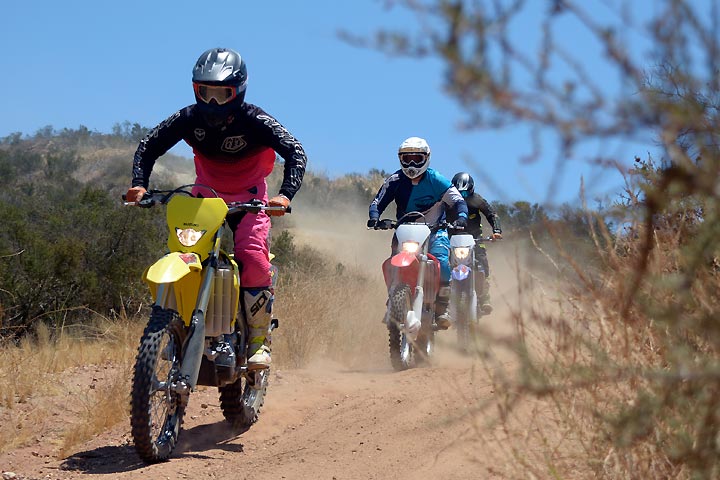
By contrast, both the Yamaha and the Honda have issues that hinder their ergos. With the Yamaha, it’s a wide feeling through the forward part of the chassis where the airbox resides. That makes it difficult for some riders to get as far forward on the WR450F as on the RMX450Z when cornering, and at least one rider reported that he was snagging his legs on the WR’s radiator shrouds. The Honda feels even more bulky, however. The CRF450X feels like the biggest bike in its class, especially through the mid-section where the rider grips the bike with his or her legs. It’s also the most difficult bike with which to get your weight forward for tighter turns.
On The Brakes
The Yamaha has the biggest front brake in this Green Sticker 450cc Shootout, sporting the same 270mm front and 245mm rear disc as its YZ siblings, and the combination works well in the off-road environment, delivering strong and linear performance without fading. The Suzuki’s 250mm front and 240mm rear discs also have a linear in slow- or high-speed sections. The Honda may have the smallest overall brake package with 240mm discs front and rear, but you don’t notice any difference. The CRF450X’s brakes deliver good feel, easy modulation and plenty of power without any undesirable tendency to lock up the wheels.
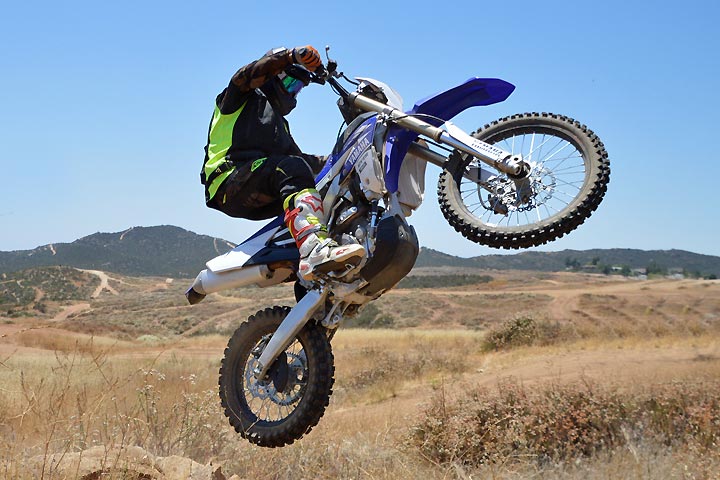
While there are plenty of differences that add up to help us determine the winner of this comparison, braking performance among these three off-road bikes isn’t one of them. We’d call it a three-way draw.
Other Stuff
We really like the RMX’s multi-function computer, which features both Standard and Sport modes. Standard mode functions include a speedometer, odometer, clock, dual trip meters and a voltage meter. Sport mode adds a timer, average speed and a trip meters, and the function of the computer is pretty intuitive.
Our biggest gripe with the Suzuki, however, has to do with its electric start system. Unlike the Honda and the Yamaha, the RMX features a power-up button that must be turned on in order to send juice to the starter, and it’s easy to forget to turn it back off. Leaving it on kills the battery, and then you have to use the kick starter in order to start the bike. Simply put, the Suzuki doesn’t like to be kick started because its fuel-injection is so lean. It takes several kicks to get the Suzuki fired, hot or cold.
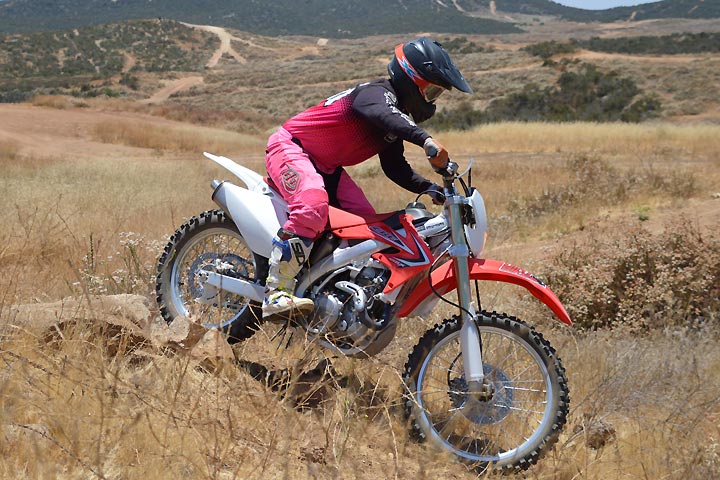
The Yamaha WR450F has the biggest fuel cell in this shootout, but our veteran off-road crew still felt that a true off-road machine should have a larger fuel cell. Like the Honda and the Suzuki, the Yamaha also features a beefy skid plate but lacks hand guards. The Honda CRF450X has the wimpiest skid plate of the three bikes in this test, but at least it comes with a stock front rotor guard, an item not found on the Yamaha or the Suzuki.
The Final Verdict
For casual trail riding, you can’t go wrong with any of these Green Sticker 450cc Shootout machines, but if we could choose just one, it would be the Yamaha YZ450F. The Yamaha’s engine packs the most punch in emissions-legal form, and it handles low- and high-speed terrain with equal competence. It goes fast, turns well and stops well, and its KYB suspension is the best of the group when it comes to delivering the right mix of plushness and control in the chop.
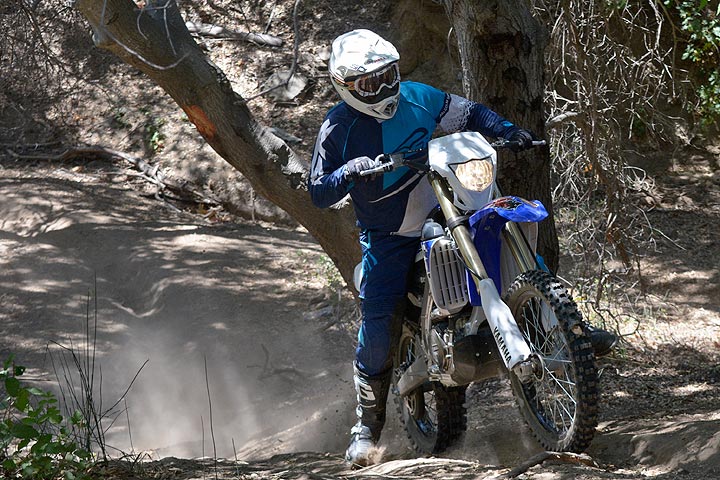
The venerable Honda CRF450X takes second place easily. Even though it is still carbureted, the Honda oozes smooth power down low and is easy to ride. We’d just like to see it deliver a little more snap and a little more top-end thrust. We know that the CRF’s super-stable chassis could handle the extra power, and its suspension is very good at taming large and small obstacles on the trail. The CRF may lack the corner-carving ability of the other two bikes here, but it’s definitely a good choice for fast, open desert terrain.
The Suzuki RMX450Z comes in a distant third. The basic platform is good, but its seriously choked engine performance, stiff chassis and irritating electric start power-up button are details that would need to be sorted out in order to bring the Suzuki closer to the Yamaha and the Honda. Those are items we know can be fixed if Suzuki wants make the effort.
Overall, we’re all winners because these three off-road bikes can be purchased from the showroom floor and ridden on any public OHV land in the country, and if you want to pull a couple screws and remove a few other items, all three can be quickly transformed into pretty darn good closed-course off-roaders.
But, for us, the Yamaha WR450F is the meanest of the greens, and it leaves the other two bikes here singing the blues.
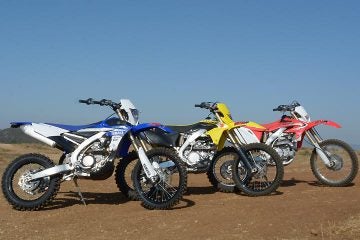 2017 Honda CRF450X Specifications
2017 Honda CRF450X Specifications
MSRP: $8699
Engine
Type: 449cc, 4-stroke, liquid-cooled, single cylinder, SOHC
Bore Stroke: 96.0mm x 62.0mm
Compression Ratio: 12.0:1
Fuel System: Keihin 41mm carburetor w/throttle position sensor
Starter: Electric w/backup kick starter
Lubrication: Twin-sump (engine and transmission feature separate sumps)
Ignition: CD w/electronic advance and lighting coil
Transmission: 5-speed constant mesh
Final Drive: Chain, 13T/51T
Chassis
Rake/Trail: 27.10°/110.0mm (4.3 in.)
Wheelbase: 1481mm (58.3 in.)
Ground Clearance: 345mm (13.6 in.)
Seat Height: 960mm (37.8 in.)
Claimed Curb Weight: 122.2 kg (269 lbs.)
Weight (as tested): 123.5 kg (271.8 lbs.), 129.7 lbs. (front)/142.1 lbs. (rear); 48%/52%
Suspension Front: 47mm Showa coil spring inverted telescopic fork, fully adjustable, 12.4 in. of travel
Suspension Rear: Pro-Link w/Showa piggyback reservoir shock, fully adjustable, 12.4 in. of travel
Brakes Front: 240mm disc brake w/twin-piston caliper
Brakes Rear: 240mm disc brake w/single-piston caliper
Tires Front: 80/100-21
Tires Rear: 110/100-18
Fuel Tank Capacity: 7.2 L (1.9 US gallons)
Color: Red
2017 Suzuki RMX450Z Specifications
MSRP: $8999
Engine
Type: 449cc, 4-stroke, liquid-cooled, single cylinder, DOHC
Bore Stroke: 96.0mm x 62.1mm
Compression Ratio: 11.6:1
Fuel System: Keihin fuel injection w/41mm throttle body
Starter: Electric w/backup kick starter
Lubrication: Semi-dry sump
Ignition: Electronic ignition (CDI)
Transmission: 5-speed constant mesh
Final Drive: Chain, 13T/50T
Chassis
Rake/Trail: 29° 18’/129.5mm (5.1 in.)
Wheelbase: 1485mm (58.5 in.)
Ground Clearance: 320mm (12.6 in.)
Seat Height: 950mm (37.4 in.)
Claimed Curb Weight: 123.5 kg (272lbs.)
Weight (as tested): 123 kg (271.2 lbs.), 127.6 lbs. (front)/143.6 lbs. (rear); 47%/53%
Suspension Front: 47mm Showa coil spring inverted telescopic fork, fully adjustable, 12.2 inches of travel
Suspension Rear: Link type w/Showa piggyback reservoir shock, fully adjustable, 12.2 inches of travel
Brakes Front: 250mm disc brake w/twin-piston caliper
Brakes Rear: 240mm disc brake w/single-piston caliper
Tires Front: 80/100-21
Tires Rear: 120/90-18
Fuel Tank Capacity: 6.2 L (1.6 US gallons)
Color: Champion Yellow/Solid Black
2017 Yamaha WR450F Specifications
MSRP: $9099
Engine
Type: 449cc, 4-stroke, liquid-cooled, single cylinder, DOHC
Bore Stroke: 97.0mm x 60.8mm
Compression Ratio: 12.5:1
Fuel System: Keihin fuel injection w/44mm throttle body
Starter: Electric w/backup kick starter
Lubrication: Dry sump
Ignition: Transistor-controlled ignition (CDI)
Transmission: 5-speed constant mesh
Final Drive: Chain, 13T/50T
Chassis
Rake/Trail: 26.3°/114.3mm (4.5 in.)
Wheelbase: 1466mm (57.7 in.)
Ground Clearance: 325.1mm (12.8 in.)
Seat Height: 965.2mm (38.0 in.)
Claimed Curb Weight: 123.5 kg (271 lbs.)
Weight (as tested): 122.7 kg (270.0 lbs.), 128.7 lbs. (front)/141.3 lbs. (rear); 48%/52%
Suspension Front: 48mm KYB SSS coil spring inverted telescopic fork, fully adjustable, 12.2 inches of travel
Suspension Rear: Link type w/KYB piggyback reservoir shock, fully adjustable, 12.5 inches of travel
Brakes Front: 270mm disc brake w/twin-piston caliper
Brakes Rear: 245mm disc brake w/single-piston caliper
Tires Front: 80/100-21
Tires Rear: 120/90-18
Fuel Tank Capacity: 7.6 L (2.0 US gallons)
Color: Blue
 Your Privacy Choices
Your Privacy Choices